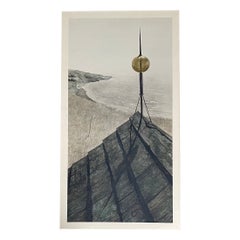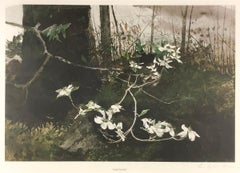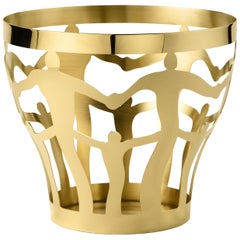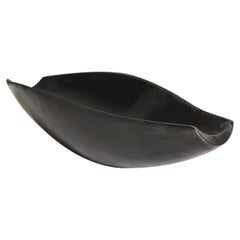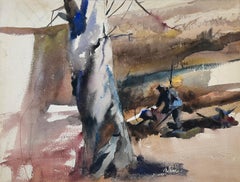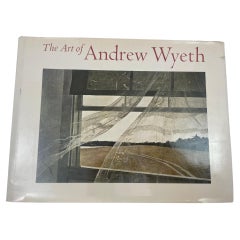Andrew Wyeth Furniture
American, 1917-2009
An artist who pursued his own course when the rest of the art world was consumed with modernism and abstraction, Wyeth is considered among the preeminent representational painters of the 20th century. Born in Chadds Ford, Pennsylvania, Wyeth drew his subject matter from the world around him: the interiors and exteriors of the stone buildings, mills, and farms of the Brandywine River countryside, and in the summers, the clapboard houses and stark landscape of the Maine coast. After his father died in a 1945 automobile accident, Wyeth began to incorporate people into his pictures, most notably Christina Olson, and later Siri Erickson, of Cushing, Maine, and his Chadds Ford neighbors Karl and Anna Kuerner and Helga Testorf. The first visual artist to appear on the cover of Time magazine, Wyeth was also the first living American-born artist to be given an exhibition at The Metropolitan Museum of Art in New York.
Wyeth’s naturalistic style is marked by strong editing combined with remarkable execution of details. While relying on keen visual observation, he pared down the elements of a composition to their most essential, giving his works an abstracted quality and imbuing them with a sense of quietude and stillness. The egg tempera medium (which he came to prefer to oil after first experimenting with it in the early 1940s) lent itself to the precise detailing required to create his subtle textural effects, since it dries quickly and translucent layers can be built up over one another. Wyeth also painted extensively in watercolor in works of more spontaneous execution, as well as in the drybrush technique (where most water is removed from the watercolor medium), sometimes combining the two.to
1
3
3
2
1
"Nothern Point" Color Collotype Print by Andrew Wyeth
By Andrew Wyeth
Located in San Diego, CA
"Nothern Point" signed in print color collotype print by Andrew Wyeth, circa 1950s. The piece is in very good vintage condition and comes unframed mounted on board. This wonderful pi...
Category
20th Century American Andrew Wyeth Furniture
Materials
Wood
$680 Sale Price
20% Off
Royal Doulton Porcelain Bowl Designed by Andrew Wyeth England 1973
By Andrew Wyeth, Royal Doulton
Located in North Hollywood, CA
Vintage Royal Doulton Porcelain Bowl Designed by Andrew Wyeth England 1973.
Amazing Royal Doulton Andrew Wyeth large porcelain bowl with apple branches 13" Limited Ed.
Andrew Wyeth bowl made of fine English bone China. The bowl was made for Andrew Wyeth by Royal Doulton of Stoke-on-Trent, Staffordshire, England.
Limited edition from an original work of art by Andrew Wyeth...
Category
Late 20th Century English Victorian Andrew Wyeth Furniture
Materials
Porcelain
Dogwood
By Andrew Wyeth
Located in Missouri, MO
Andrew Wyeth
"Dogwood" 1983
Collotype
Ed. 115/300
Signed and Numbered Lower Right
Image Size: 21 x 28 3/4 inches
Framed Size: approx. 29 x 36.5 inches
A painter of landscape and figure subjects in Pennsylvania and Maine, Andrew Wyeth became one of the best-known American painters of the 20th century. His style is both realistic and abstract, and he works primarily in tempera and watercolor, often using the drybrush technique.
He is the son of Newell Convers and Carolyn Bockius Wyeth of Chadds Ford, Pennsylvania, and was home-schooled because of delicate health. His art instruction came from his famous-illustrator father, who preached the tying of painting to life--to mood and to essences and to capturing the subtleties of changing light and shadows.
The Wyeth household was a lively place with much intellectual and social stimulation. Because of the prominence of N.C. Wyeth, persons including many dignitaries came from all over the country to visit the family. Andrew's sisters Carolyn and Henriette became noted artists as did his brother-in-law, Peter Hurd. The non-art oriented brother, Nathaniel Wyeth...
Category
1980s American Modern Andrew Wyeth Furniture
Materials
Paper, Lithograph
Price Upon Request
Related Items
Ghidini 1961 Cestino 2 Large Bowl in Polished Brass by Andrea Branzi
By Ghidini 1961, Andrea Branzi
Located in Villa Carcina, IT
"The dance, intended as an eternal circle and sacred ritual and celebration of the ancient tribal traditions." This is the reference of Andrea Branzi when he thought of this series of three pieces that define these new vase...
Category
21st Century and Contemporary Italian Modern Andrew Wyeth Furniture
Materials
Brass
$832 / item
H 9.06 in Dm 10.24 in
Contemporary Black Copper Bai He Tray by Robert Kuo, Hand Repousse
By Robert Kuo
Located in Los Angeles, CA
Bai He tray
Black copper
Hand repoussé
Limited edition
Each piece is individually crafted and is unique.
Repoussé is the traditional art of hand-hammering decorative relief o...
Category
2010s Modern Andrew Wyeth Furniture
Materials
Copper
$600 / item
H 4.75 in W 17.5 in D 7.5 in
Andrew Wyeth Black & White Pencil Sketch Print
Located in Seattle, WA
Andrew Wyeth black & white pencil sketch print.
Titled : Study Fro April Wind.
Dimensions. 27 W ; 21 H.
Category
1970s Mid-Century Modern Vintage Andrew Wyeth Furniture
Materials
Wood
2 Lovely Robert Kipniss Lithographs titled "Leaning" & "Interiors"
By Robert Kipniss
Located in New York, NY
Robert Kipniss (American, b. 1931)
Left:
Leaning, c. 1988
Lithograph
Sight: 5 1/4 x 4 in.
Framed: 11 x 9 3/4 x 3/4 in.
Numbered lower left: 53/175
Signed lower right: Kipniss
Right...
Category
1980s American Modern Andrew Wyeth Furniture
Materials
Lithograph
$1,000
H 16 in W 13.125 in D 0.5 in
Royal England Blue and White Porcelain Bowl by Wood & Son
By Wood & Son
Located in Miami, FL
Marked "TRILBY"
ROYAL SEMI-PORCELAIN
WOOD & SON
ENGLAND
Brand: Wood & Son
Style: flow blue
Item: Bowl
Pattern: Trilby
Material: Porcelain
Design:...
Category
Late 19th Century English Victorian Antique Andrew Wyeth Furniture
Materials
Porcelain
Prodigal Son
By Thomas Hart Benton
Located in London, GB
A man raises his hand to his chin, his neck tilted and face turned to look at a dilapidated farmhouse, barely held together by planks of wood and exposed to the elements. Behind him ...
Category
1930s American Modern Andrew Wyeth Furniture
Materials
Lithograph
Haystack
By Thomas Hart Benton
Located in London, GB
A fine impression of this very popular image with full margins (smaller on top and bottom) published by Associated American Artists.
Category
1930s American Modern Andrew Wyeth Furniture
Materials
Lithograph
Nebraska Evening
By Thomas Hart Benton
Located in London, GB
A fine impression with good margins published by Associated American Artists.
Category
1940s American Modern Andrew Wyeth Furniture
Materials
Lithograph
Summer Gold, American Modern Lithograph by Millard Sheets
By Millard Sheets
Located in Long Island City, NY
Artist: Millard Owen Sheets, American (1907 - 1989)
Title: Summer Gold
Medium: Lithograph, signed and numbered in pencil
Edition: 250, 5 HC
Image S...
Category
1970s American Modern Andrew Wyeth Furniture
Materials
Lithograph
$1,500
H 27 in W 38.5 in
"Rupi" Sand Cast Bronze Bowl by Jaimal Odedra
By Jaimal Odedra
Located in New York, NY
"Rupi"
Bronze bowl by Jaimal Odedra. The "Rupi" bowls are made in five sizes, which may be used individually or as a set of nesting bowls. This is the third largest size out of fi...
Category
2010s Moroccan Andrew Wyeth Furniture
Materials
Bronze
Amaina Print "Midnight Moon", blue color signed and titled Blue Color USA
Located in Auribeau sur Siagne, FR
Amaina Print "Midnight Moon", blue color signed and titled Blue Color USA
Category
20th Century American American Classical Andrew Wyeth Furniture
Materials
Wood, Paper
$331 Sale Price
20% Off
H 1.58 in W 18.9 in D 18.9 in
Royal Doulton Egyptian Revival Porcelain Jardinière
By Royal Doulton
Located in Stamford, CT
Royal Doulton jardinière made during the Egyptian Revival period.
Category
Early 20th Century English Egyptian Revival Andrew Wyeth Furniture
Materials
Porcelain
Previously Available Items
Beech Tree, Watercolor Landscape by Chadds Ford Artist Andrew Wyeth
By Andrew Wyeth
Located in Doylestown, PA
Beech Tree is a watercolor and pencil on paper landscape and figurative work by American painter Andrew Wyeth. The 21 3/4 x 29 1/8 inches work is framed and matted behind museum glas...
Category
1930s American Realist Andrew Wyeth Furniture
Materials
Watercolor, Archival Paper, Pencil
H 32 in W 40.25 in D 2 in
The Art of Andrew Wyeth by Corn, Wanda M by Corn, Wanda M Hardcover 1st Ed. 1973
By Andrew Wyeth
Located in North Hollywood, CA
The Art of Andrew Wyeth by Wanda M. Corn hardcover book.
Published by The Fine Arts Museum of San Francisco.
First printing. First Edition: 197...
Category
Late 20th Century American Expressionist Andrew Wyeth Furniture
Materials
Paper
H 9.5 in W 12 in D 1 in
April Wind Lithograph by Andrew Wyeth
By Andrew Wyeth
Located in Los Angeles, CA
Framed lithograph of Andrew Wyeth's 1952 work, April Wind.
Dimensions
32” width x 26” height and extends 1.5” from the wall.
Condition
Good vintage condition; professionally clea...
Category
1950s American Mid-Century Modern Vintage Andrew Wyeth Furniture
Materials
Wood, Paper
Split Ash Basket, Karl's Room, The Scarecrow, The Fortune, Shed Lantern, Bundle
By Andrew Wyeth
Located in Chesterfield, MI
Bulk Sale of nine posters
Dimensions for packaging: two tubes measuring 43 in x 4 in - two shipping labels needed (1/1 and 1/2)
Category
20th Century Andrew Wyeth Furniture
Materials
Lithograph
Andrew Wyeth "Christina's World" Framed Collotype Print 1976 Limited Edition
By Andrew Wyeth
Located in Dayton, OH
“Christina’s World – Study, 1948” by Andrew Wyeth. Professionally framed. From a portfolio of 10 facsimile collotype prints of drawings by Andrew Wyet...
Category
1970s American Classical Vintage Andrew Wyeth Furniture
Materials
Paper
H 31 in W 1 in D 33.5 in
Andrew Wyeth "The Keurners" Framed Collotype Portrait Print 1976 Limited Edition
By Andrew Wyeth
Located in Dayton, OH
"“The Kuerners – study, 1971” by Andrew Wyeth. Professionally framed. From a portfolio of 10 facsimile collotype prints of drawings by Andrew Wyeth. Produced by The Metropolitan Muse...
Category
1970s American Classical Vintage Andrew Wyeth Furniture
Materials
Paper
H 38.5 in W 1 in D 41.25 in
Andrew Wyeth "Evening at Kuerners" Landscape Framed Collotype Print Lim Ed 1976
By Andrew Wyeth
Located in Dayton, OH
“Evening at Kuerners – Study, 1970” by Andrew Wyeth. Professionally framed. From a portfolio of 10 facsimile collotype prints of drawings produced by The Metropolitan Museum of Art, ...
Category
1970s American Classical Vintage Andrew Wyeth Furniture
Materials
Paper
H 34.5 in W 1 in D 38 in
Andrew Wyeth Collotype Print Spring Fed Cows 1976 Metropolitan Museum
By Andrew Wyeth
Located in Dayton, OH
Spring Fed – Study, 1967” by Andrew Wyeth. From a portfolio of 10 facsimile collotype prints of drawings by Andrew Wyeth. Produced by The Metropolitan Museum of Art, 1976. The portfo...
Category
1970s American Classical Vintage Andrew Wyeth Furniture
Materials
Paper
Andrew Wyeth Collotype Print Snow Flurries Landscape 1976 Metropolitan Museum 24
By Andrew Wyeth
Located in Dayton, OH
“Snow Flurries – Study 1953” by Andrew Wyeth. From a portfolio of 10 facsimile collotype prints of drawings by Andrew Wyeth. Produced by The Metropolitan Museum of Art, 1976. The por...
Category
1970s American Classical Vintage Andrew Wyeth Furniture
Materials
Paper
H 16.25 in W 0.125 in D 23.75 in
Andrew Wyeth Collotype Print New England 1976 Metropolitan Museum
By Andrew Wyeth
Located in Dayton, OH
“New England – Study, 1960” by Andrew Wyeth. From a portfolio of 10 facsimile collotype prints of drawings by Andrew Wyeth. Produced by The Metropolitan Museum of Art, 1976. The port...
Category
1970s American Classical Vintage Andrew Wyeth Furniture
Materials
Paper
Andrew Wyeth Collotype Print Spring Fed Kitchen Sink 1976 Metropolitan Museum 20
By Andrew Wyeth
Located in Dayton, OH
“Spring Fed – Study, 1967” by Andrew Wyeth. From a portfolio of 10 facsimile collotype prints of drawings by Andrew Wyeth. Produced by The Metropolitan Museum of Art, 1976. The portf...
Category
1970s American Classical Vintage Andrew Wyeth Furniture
Materials
Paper
H 24.75 in W 0.125 in D 31.5 in
Andrew Wyeth Collotype Print My Young Friend Portrait 1976 Metropolitan Museum 2
By Andrew Wyeth
Located in Dayton, OH
My Young Friend – Study, 1970” by Andrew Wyeth. From a portfolio of 10 facsimile collotype prints of drawings by Andrew Wyeth. Produced by The Metropolitan Museum of Art, 1976. The p...
Category
1970s American Classical Vintage Andrew Wyeth Furniture
Materials
Paper
H 17 in W 0.125 in D 19.75 in
Andrew Wyeth furniture for sale on 1stDibs.
Andrew Wyeth furniture are available for sale on 1stDibs. These distinctive items are frequently made of wood and are designed with extraordinary care. There are many options to choose from in our collection of Andrew Wyeth furniture, although gray editions of this piece are particularly popular. Many of the original furniture by Andrew Wyeth were created in the Victorian style in united states during the 20th century. If you’re looking for additional options, many customers also consider furniture by Adderley Ware, John Taylor, Powell, and Bishop & Stonier. Prices for Andrew Wyeth furniture can differ depending upon size, time period and other attributes — on 1stDibs, these items begin at $275 and can go as high as $850, while a piece like these, on average, fetch $650.
Creators Similar to Andrew Wyeth
Questions About Andrew Wyeth Furniture
- 1stDibs ExpertFebruary 22, 2021An Andrew Wyeth painting can be worth anywhere from $200 to over $80 million. 1stDibs.com sells a number of paintings from Andrew Wyeth.
